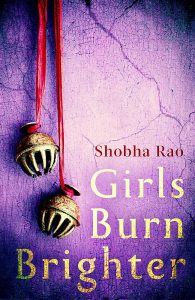 Published by Flatiron US/Fleet UK
Published by Flatiron US/Fleet UK
March/May 2018
Reviewed by Elsbeth Lindner
Devastating is hardly an adequate adjective to describe the horrors visited on the two central characters of Rao’s scorching debut, and by extension uncounted numbers of actual impoverished women and female children in India, some of whose suffering occasionally appears in stories in our newspapers. This saga of cruelty, subjugation, sexual abuse, marital oppression, prostitution and pain of other heart-wrenching kinds also, of course, comes perfectly timed to ride the current wave of female outrage animating voices of resistance in many countries.
Following on from her noted short story collection An Unrestored Woman, Rao has delivered a tale of female friendship between two pained souls, Poornima and Savitha, whose home village in India is a renowned weaving centre. Poornima has known little tenderness in life. Her recollections of time spent with her mother, and of simple caring moments, such as having her hair combed, are scattered points of light in a parched existence dominated by servitude to a callous father and young siblings. Savitha’s family is even poorer, her father having drunk away such money as they had. Although her childhood was spent picking over trash heaps, Savitha is blessed with spinning and weaving skills which bring her into the employment of Poornima’s father. Once the girls meet, a bond springs to life, infinite and unbreakable, bringing tenderness and hope to existences filled with work, heat, dust and the merest scraps of self-determination.
Inevitably the girls will be separated, each moving toward a different version of tragedy, Poornima’s through marriage into a rapacious family whose response to a shortfall in their dowry expectations is cold-blooded and appalling. Savitha’s suffering begins earlier, with rape, but far worse will follow. These are women who will be stripped down to their essences – survival, endurance, and the flickering spirit that lifts them above the trials of their flesh.
While later sections of this novel begin to take on a less plausible and striking form, its overwhelming momentum derives from Rao’s panorama of a culture still deeply immersed in extreme gender disparity: ‘Every moment in a woman’s life was a deal, a deal of her body: first for its blooming and then for its wilting; first for her bleeding and then for her virginity and then for her bearing and then for her widowing.’ Money might soften the contours or widen the possibilities, but the structure is rotten and, at its, worst medieval.
Narrated in simple phrasing, the book offers poetic and philosophical moments, alert to the endless beauties of life, even when lived at its harshest. A scrap of cloth, a piece of fruit, an empty sky – all illumine the text. But there’s a continuous thread of rage too, often seen in Rao’s continuous metaphor of light and fire which bears both the worst and best of these women’s existences.
